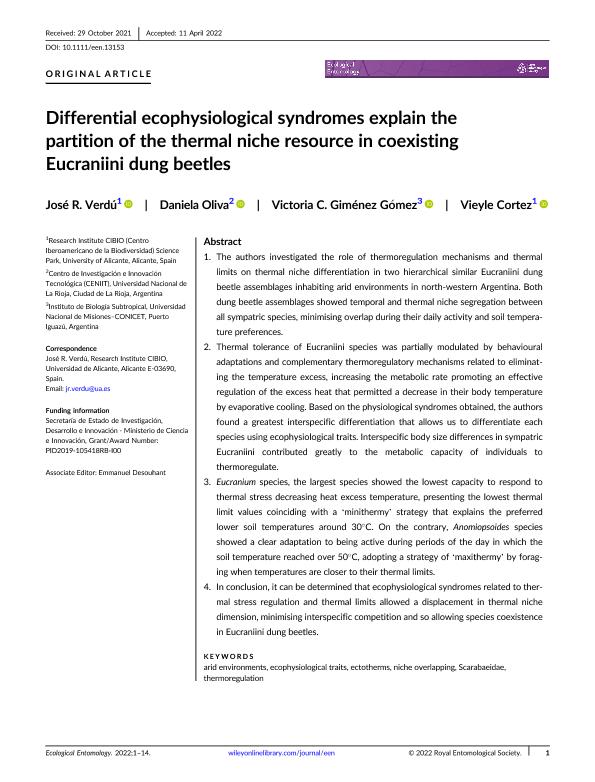Mostrar el registro sencillo del ítem
dc.contributor.author
Verdú Faraco, José Ramón

dc.contributor.author
Oliva, Daniela
dc.contributor.author
Gimenez Gomez, Victoria Carolina

dc.contributor.author
Cortez, Vieyle
dc.date.available
2023-09-22T17:12:54Z
dc.date.issued
2022-04
dc.identifier.citation
Verdú Faraco, José Ramón; Oliva, Daniela; Gimenez Gomez, Victoria Carolina; Cortez, Vieyle; Differential ecophysiological syndromes explain the partition of the thermal niche resource in coexisting Eucraniini dung beetles; Wiley Blackwell Publishing, Inc; Ecological Entomology; 47; 4; 4-2022; 689-702
dc.identifier.issn
0307-6946
dc.identifier.uri
http://hdl.handle.net/11336/212767
dc.description.abstract
The authors investigated the role of thermoregulation mechanisms and thermal limits on thermal niche differentiation in two hierarchical similar Eucraniini dung beetle assemblages inhabiting arid environments in north-western Argentina. Both dung beetle assemblages showed temporal and thermal niche segregation between all sympatric species, minimising overlap during their daily activity and soil temperature preferences. Thermal tolerance of Eucraniini species was partially modulated by behavioural adaptations and complementary thermoregulatory mechanisms related to eliminating the temperature excess, increasing the metabolic rate promoting an effective regulation of the excess heat that permitted a decrease in their body temperature by evaporative cooling. Based on the physiological syndromes obtained, the authors found a greatest interspecific differentiation that allows us to differentiate each species using ecophysiological traits. Interspecific body size differences in sympatric Eucraniini contributed greatly to the metabolic capacity of individuals to thermoregulate. Eucranium species, the largest species showed the lowest capacity to respond to thermal stress decreasing heat excess temperature, presenting the lowest thermal limit values coinciding with a ‘minithermy’ strategy that explains the preferred lower soil temperatures around 30°C. On the contrary, Anomiopsoides species showed a clear adaptation to being active during periods of the day in which the soil temperature reached over 50°C, adopting a strategy of ‘maxithermy’ by foraging when temperatures are closer to their thermal limits. In conclusion, it can be determined that ecophysiological syndromes related to thermal stress regulation and thermal limits allowed a displacement in thermal niche dimension, minimising interspecific competition and so allowing species coexistence in Eucraniini dung beetles.
dc.format
application/pdf
dc.language.iso
eng
dc.publisher
Wiley Blackwell Publishing, Inc

dc.rights
info:eu-repo/semantics/openAccess
dc.rights.uri
https://creativecommons.org/licenses/by/2.5/ar/
dc.subject
ARID ENVIRONMENTS
dc.subject
ECOPHYSIOLOGICAL TRAITS
dc.subject
ECTOTHERMS
dc.subject
NICHE OVERLAPPING
dc.subject
SCARABAEIDAE
dc.subject
THERMOREGULATION
dc.subject.classification
Ecología

dc.subject.classification
Ciencias Biológicas

dc.subject.classification
CIENCIAS NATURALES Y EXACTAS

dc.subject.classification
Biología

dc.subject.classification
Ciencias Biológicas

dc.subject.classification
CIENCIAS NATURALES Y EXACTAS

dc.title
Differential ecophysiological syndromes explain the partition of the thermal niche resource in coexisting Eucraniini dung beetles
dc.type
info:eu-repo/semantics/article
dc.type
info:ar-repo/semantics/artículo
dc.type
info:eu-repo/semantics/publishedVersion
dc.date.updated
2023-07-07T22:04:08Z
dc.journal.volume
47
dc.journal.number
4
dc.journal.pagination
689-702
dc.journal.pais
Reino Unido

dc.journal.ciudad
Londres
dc.description.fil
Fil: Verdú Faraco, José Ramón. Universidad de Alicante; España
dc.description.fil
Fil: Oliva, Daniela. Universidad Nacional de La Rioja; Argentina
dc.description.fil
Fil: Gimenez Gomez, Victoria Carolina. Consejo Nacional de Investigaciones Científicas y Técnicas. Centro Científico Tecnológico Conicet - Nordeste. Instituto de Biología Subtropical. Instituto de Biología Subtropical - Nodo Posadas | Universidad Nacional de Misiones. Instituto de Biología Subtropical. Instituto de Biología Subtropical - Nodo Posadas; Argentina
dc.description.fil
Fil: Cortez, Vieyle. Universidad de Alicante; España
dc.journal.title
Ecological Entomology

dc.relation.alternativeid
info:eu-repo/semantics/altIdentifier/url/https://resjournals.onlinelibrary.wiley.com/doi/10.1111/een.13153
dc.relation.alternativeid
info:eu-repo/semantics/altIdentifier/doi/https://doi.org/10.1111/een.13153
Archivos asociados
